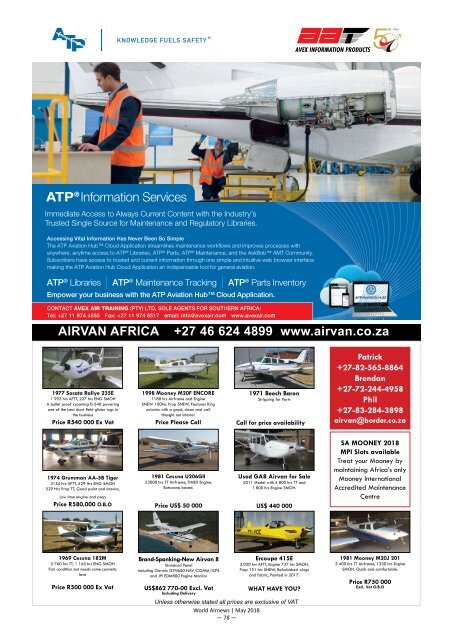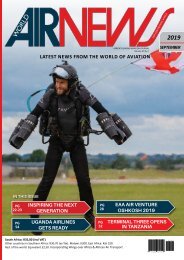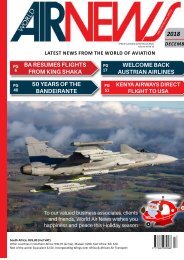World AirNews June 2018
- No tags were found...
Create successful ePaper yourself
Turn your PDF publications into a flip-book with our unique Google optimized e-Paper software.
230x188 ATP Advert Global Aviator OUT PRESS.pdf 1 15/11/2016 12:29 PM<br />
COLUMN<br />
Wooden Overcoat<br />
AIRVAN AFRICA<br />
1977 Socata Rallye 235E<br />
1 993 hrs AFTT, 227 hrs ENG SMOH<br />
A bullet proof Lycoming 0-540 powering<br />
one of the best short field glider tugs in<br />
the business<br />
Price R540 000 Ex Vat<br />
1974 Grumman AA-5B Tiger<br />
3154 hrs AFTT, 529 Hrs ENG SMOH<br />
529 Hrs Prop TT, Good paint and interior,<br />
Low time engine and prop<br />
Price R580,000 O.B.O<br />
1969 Cessna 182M<br />
5 760 hrs TT, 1 165 hrs ENG SMOH<br />
Fair condition but needs some cosmetic<br />
love<br />
Price R500 000 Ex Vat<br />
+27 46 624 4899 www.airvan.co.za<br />
1998 Mooney M20F ENCORE<br />
1180 hrs Airframe and Engine<br />
SNEW 100hrs Prop SNEW, Features King<br />
avionics with a good, clean and well<br />
thought out interior<br />
Price Please Call<br />
1981 Cessna U206GII<br />
23000 hrs TT Airframe, TIMEX Engine.<br />
Botswana based.<br />
Price US$ 50 000<br />
Brand-Spanking-New Airvan 8<br />
Standard Panel<br />
including Garmin GTN650 NAV/COMM/GPS<br />
and JPI EDM800 Engine Monitor<br />
US$862 770-00 Excl. Vat<br />
Including Delivery<br />
1971 Beech Baron<br />
Stripping for Parts<br />
Call for price availability<br />
Used GA8 Airvan for Sale<br />
2011 Model with 5 800 hrs TT and<br />
1 800 hrs Engine SMOH.<br />
US$ 440 000<br />
Ercoupe 415E<br />
2 020 hrs AFTT, Engine 737 hrs SMOH,<br />
Prop 151 hrs SNEW, Refurbished wings<br />
and fabric, Painted in 2017.<br />
WHAT HAVE YOU?<br />
Unless otherwise stated all prices are exclusive of VAT<br />
<strong>World</strong> Airnews | May <strong>2018</strong><br />
— 78 —<br />
Patrick<br />
+27-82-565-8864<br />
Brendan<br />
+27-72-244-4958<br />
Phil<br />
+27-83-284-3898<br />
airvan@border.co.za<br />
SA MOONEY <strong>2018</strong><br />
MPI Slots available<br />
Treat your Mooney by<br />
maintaining Africa’s only<br />
Mooney International<br />
Accredited Maintenance<br />
Centre<br />
1981 Mooney M20J 201<br />
3 400 hrs TT Airframe, 1330 hrs Engine<br />
SMOH. Quick and comfortable.<br />
Price R750 000<br />
Excl. Vat O.B.O<br />
S<br />
OME WEEKS ago I received an<br />
email from James Forson asking me<br />
if I would like to write a “crit” on a book<br />
entitled “Wooden Overcoat” he had edited<br />
which is basically the autobiography of<br />
Peter Strong, a South African pioneer pilot,<br />
and the birth and development of his Drakensberg<br />
Air Service.<br />
My job as a Commercial Pilot was with<br />
another Basutoland airline, Basutair,<br />
which was based in the capital Maseru,<br />
so I jumped at the idea. I had heard a lot<br />
about Peter Strong and the de Havilland<br />
Dragon Rapide which was his Ladysmith,<br />
Natal-based airline’s sole aircraft. I also<br />
learned a lot about the dangers associated<br />
with flying in the Basutoland (now Lesotho)<br />
mountains during the 800 flying hours I<br />
logged during the six months I was with<br />
Basutair.<br />
I must admit that I was soon engulfed in<br />
reading the book, especially the chapters<br />
about Peter’s flying experiences, especially<br />
in Lesotho, so much so that each time I<br />
opened it, I found I was soon unable to put<br />
the book down until I was well into it and<br />
so tired that I could hardly keep my eyes<br />
open. It is that kind of book which grabs<br />
and holds firmly on to your attention.<br />
The book’s middle and later chapters centre<br />
mainly on the Drakensberg Air Service<br />
and Peter’s experiences in flying the Rapide<br />
in the mountains. But there is one chapter<br />
which describes a Cessna the DAS used to<br />
fly materials from Ladysmith in the middle<br />
of winter to Mokhotlong to build a structure<br />
to house some government service.<br />
Here, then, is a sub-edited version of the<br />
chapter written by Peter Strong:<br />
“One has to experience the sensation<br />
of spinning with a fully loaded aircraft in<br />
c loud. In a spin no very great stresses or<br />
strains are put on the aircraft itself. The<br />
danger lies in the possibility of freight<br />
breaking loose and crashing on top of the<br />
pilot, also the likelihood of not having<br />
sufficient altitude to pull out of the spin<br />
once the iced-up controls are free.<br />
“It is awful to hear great chunks of ice<br />
flying off the propeller and sticking to<br />
the sides of the machine. Very often I<br />
found that ice did not necessarily leave<br />
each propeller blade simultaneously,<br />
resulting in very dangerous vibrations,<br />
The story of the Drakensberg Air Service<br />
Peter Strong<br />
Edited by James Forson<br />
unless the engine was throttled right back,<br />
which is not at all a healthy thing to have<br />
to do when one is wrestling to keep the<br />
aircraft on an even keel and at safe altitude,<br />
with the knowledge that the mountain<br />
peaks are touching the cloud base only a<br />
few hundred feet below. It is usual to lose<br />
up to 50 percent of engine power if very<br />
severe icing occurs.<br />
“It is a very serious mishap to get into a<br />
spin at all in cloud, and it is an awful ordeal<br />
to have to sit and watch the altimeter<br />
needle rotate backwards round and round<br />
the dial as the aircraft spins faster and<br />
faster into space with the controls locked<br />
solid; then the tremendous relief of feeling<br />
the elevators, rudder and ailerons freed<br />
by the warm rain; then the spin recovery,<br />
full opposite rudder, centralise the stick<br />
and rest the tip of the thumb in the bottom<br />
centre of the dashboard to maintain that<br />
position of the stick which is so vital to spin<br />
recovery.<br />
“However experienced one may be in<br />
blind flying, I have always had to fight<br />
against the dangerous temptation of holding<br />
the stick back instead of forward when<br />
faced with the recovery of an unintentional<br />
spin. As soon as the “Turn” needle flicks<br />
over to the other side, indicating that the<br />
wings have stopped rotating, the pilot must<br />
be very quick to centralise the rudder to<br />
prevent the aircraft going into a tight spiral<br />
drive in the opposite direction.<br />
“Spins either occur to the left or to the<br />
right. Not the fear of crashing again, but….”<br />
PREFACE<br />
To write a “crit” as suggested by James<br />
Forson, especially to do so in the space<br />
available in “Hangar Talk” was almost<br />
beyond me, so I have decided to reprint<br />
James’s Preface which describes the book<br />
in detail. Here it is:<br />
<strong>World</strong> Airnews | December 2017<br />
— 4 —<br />
“This book tells the story of the Drakensberg<br />
Air Service. A brave pioneering<br />
firm that brought aviation to the Lesotho<br />
Highlands.<br />
“This book has taken a long time to be<br />
published. The original manuscript was<br />
written in the late 1950s by Peter Strong,<br />
the founder of the Drakensberg Air Service.<br />
A copy landed in my late father’s possession.<br />
My father, Robert Forson, was born<br />
in Lesotho and grew up in Mafeteng and<br />
Mokhotlong. He had a special love for Lesotho<br />
and being a journalist and a newspaper<br />
editor, it is likely that the two men’s<br />
paths crossed and the manuscript was<br />
exchanged. Perhaps my father was meant<br />
to assist in editing the manuscript.<br />
“My father died in 1960. The manuscript<br />
lay in a steel trunk until I wrote and<br />
published my father’s biography, using<br />
the papers and documents in the trunk. I<br />
then decided that the pioneering story of<br />
the Drakensberg Air Service – the Wooden<br />
Overcoat – was too important to leave in<br />
the trunk for another 50 years.<br />
“This is Peter Strong’s story of the Drakensberg<br />
Air Service, told in his own words.<br />
My editor’s hand has been light, because I<br />
wanted to preserve as much of Peter’s original<br />
story as possible. The discerning reader<br />
will forgive the parts where the details are<br />
unclear or don’t seem to follow, and will<br />
also be kind when the story ends abruptly.<br />
I think Peter had not quite finished with<br />
the manuscript before it ended up in my<br />
father’s trunk.<br />
“I have tried unsuccessfully to trace Peter’s<br />
surviving children and grandchildren.<br />
If they should read this, I urge them to<br />
get in touch with me. We share a common<br />
bond with a great man. It has been a<br />
privilege to share the exploits, dangers and<br />
efforts of an aviation pioneer of 60 years<br />
ago.” Thus ended his preface.<br />
Hardly a “crit” in the true sense of<br />
the word, admittedly, but enough to<br />
encourage any aviation-minded reader<br />
to acquire, but be careful if you do, for<br />
you will become so engrossed in the<br />
story that you might not be able to put<br />
the book down to read more another<br />
day. Q





